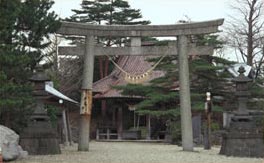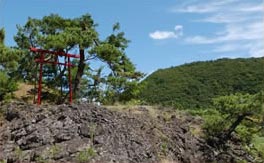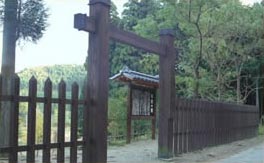Naruko-onsen-kyo Hot Spring Village has 1,000 years of history
The Naruko-onsen-kyo Hot Spring Village has more than 1,000 years of history. The hot spring was discovered in 837, when it is said that Toyagamori (Naruko volcano) erupted, and hot water gushed out. According to one theory, village people named it “Narugou no yu” after the roaring sound of that moment.
It is also known that Minamoto no Yoshitsune, who was being pursued by his brother Yoritomo, visited Naruko while trying to flee to Hiraizumi, and that Matsuo Basho chose the ancient route called “Dewa Kaido Nakayama-goe” when travelling from Naruko to Shitomae according to the Oku no Hosomichi. Thus there are many scenic spots, places of historic interest, and ancient roads associated with Yoshitsune and Basho.
Legend of Yoshitsune and Naruko
Nakiko no Hi (Monument of Nakiko)
“Nakiko no Hi” built at the side of the gate of Naruko Onsen Shrine boasts the following legend. Minamoto no Yoshitsune was being pursued by his brother Yoritomo and escaped to Hiraizumi in the far north. When Yoshitsune’s party came to the Kamewari Pass, his wife, “Kita no Kata,” gave birth to a boy named Kamewaka-maru. However, the baby had difficulty giving his first cry but finally did so when he was bathed in the Kawarayu Hot Spring. There is a theory that since that time, this area was called “Nakiko” (crying baby), which has gradually changed into the current “Naruko.”
Remains of Basho’s Oku no Hosomichi
Mizu no Kojima
This is a small island covered with old green pines floating in the Eai-gawa River. It is a place of scenic beauty that has been admired as a place famed in classical Japanese poetry since the Heian Period. In the Oku no Hosomichi, there is the following sentence: “Ogurogasaki, Mizu-no-kojima wo hete, Narugo-no-yu yori Shitomae-no-seki ni kakarite, Dewa-no-kuni ni koentosu.” (Passing Mizu-no-kojima in Ogurogasaki, I proceeded to the barrier-gate of Shitomae from Narugo hot springs, aiming to enter the country of Dewa.)
Ruins of Shitomae no Sekisho
These are the ruins of a check point (sekisho) on the Dewa-kaido Road. There is a theory that the name “Shitomae” (“shito” means “urine” in Japanese) derives from the legend that Yoshitsune’s son Kamewaka-maru first peed here. In the “Oku no Hosomichi,” it is described that when the Basho’s party visited here, they had a difficult passage because they were severely questioned by the guards.
At present, there is a representation of the check point at the time of Oku no Hosomichi and a bronze statue of Basho. In addition, on the mountain road passing through the forests that retain the atmosphere of the old road, there is a stone tablet inscribed with Basho’s haiku “Nomi- shirami Uma-no-barisuru Makuramoto.” (Flees and lice, Horses urinating, Close to my pillow.)
It was built 80 years after Basho passed here.
Oku no Hosomichi Walking Trail
In the Edo Period, Naruko was an important location on both the Dewa-kaido and Ugo-kaido roads. There were “post stations” in Shitomae, Kajiyasawa, Nakayama and Onikobe, which flourished as the “Four Tamatsukuri Stations.” Although the liveliness of the posting stations has now disappeared, approximately 8.9 km of road from Shitomae no Seki to Sakaida in Yamagata Prefecture has been preserved as the Oku no Hosomichi (Walking Trail), and visitors can stroll along the mountain road within the native forests.



